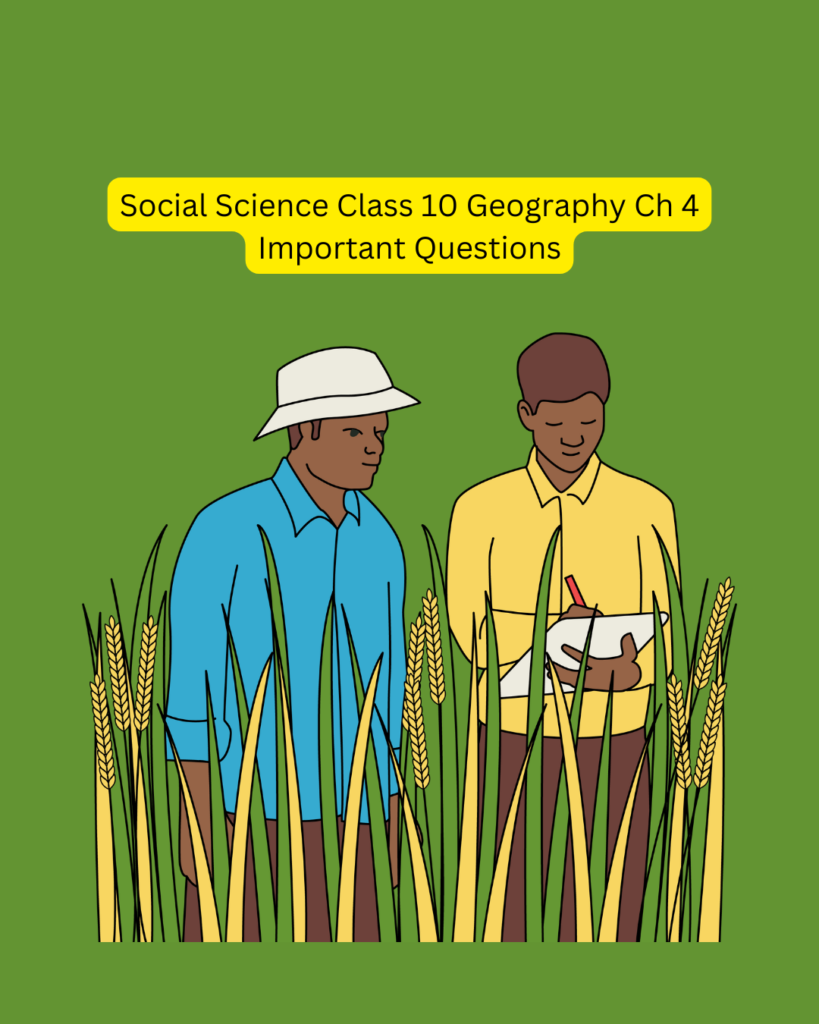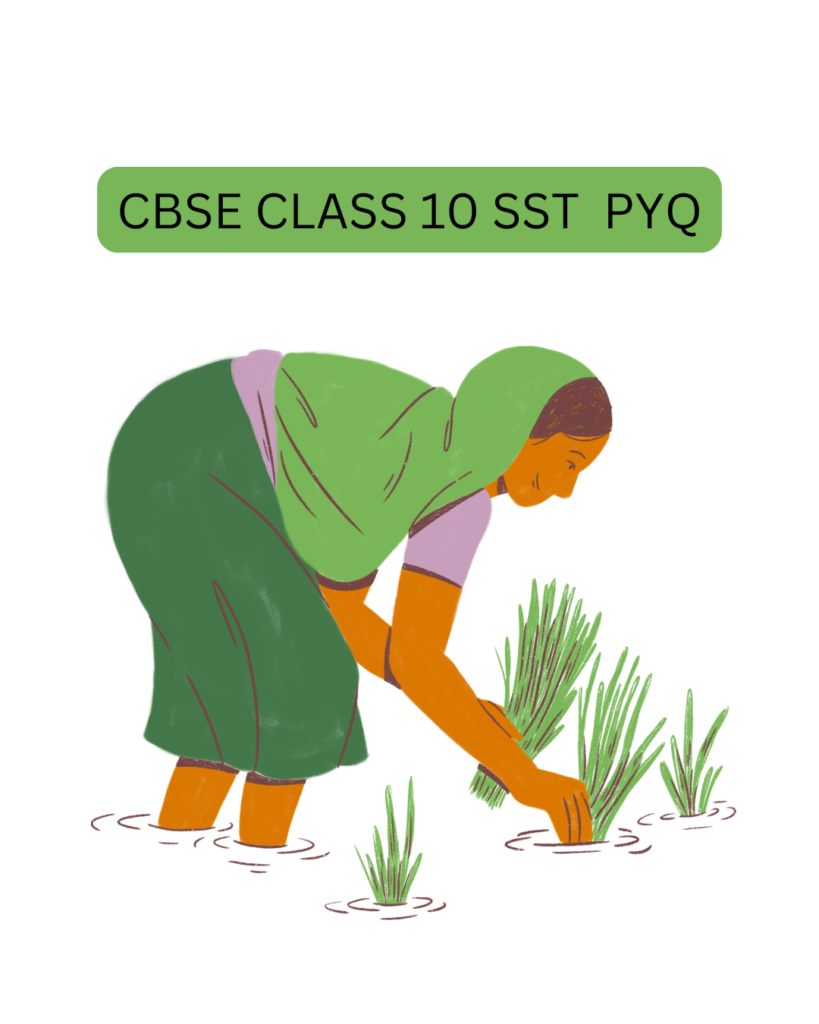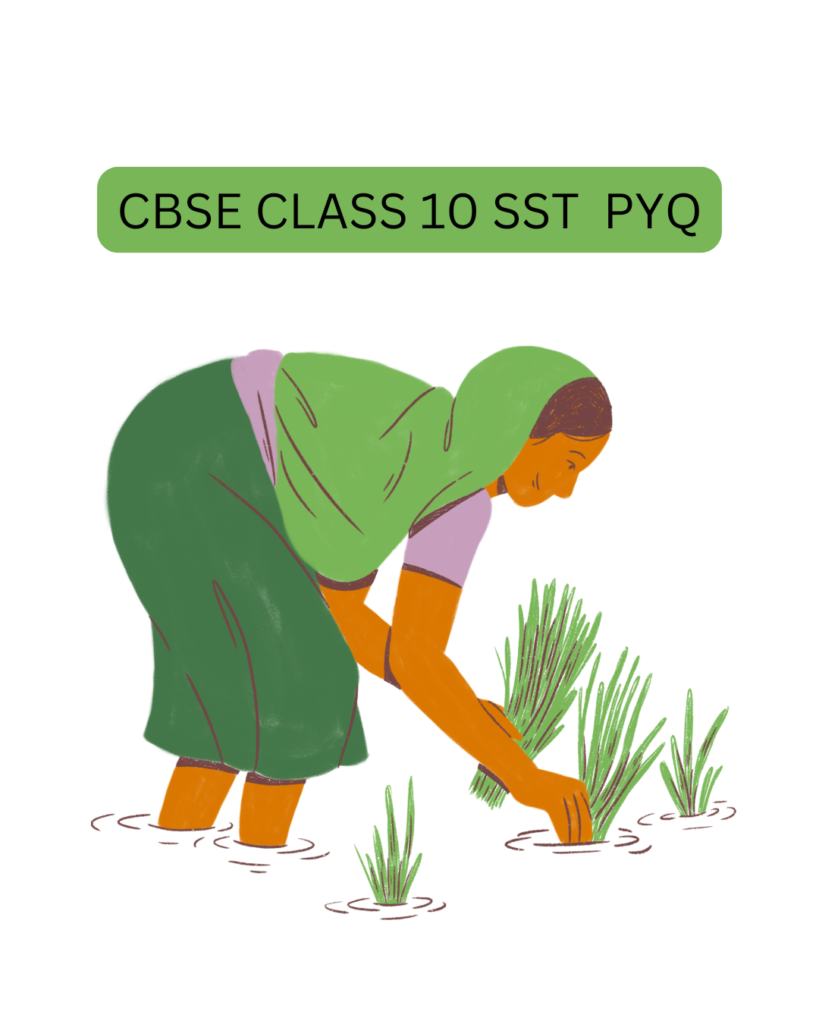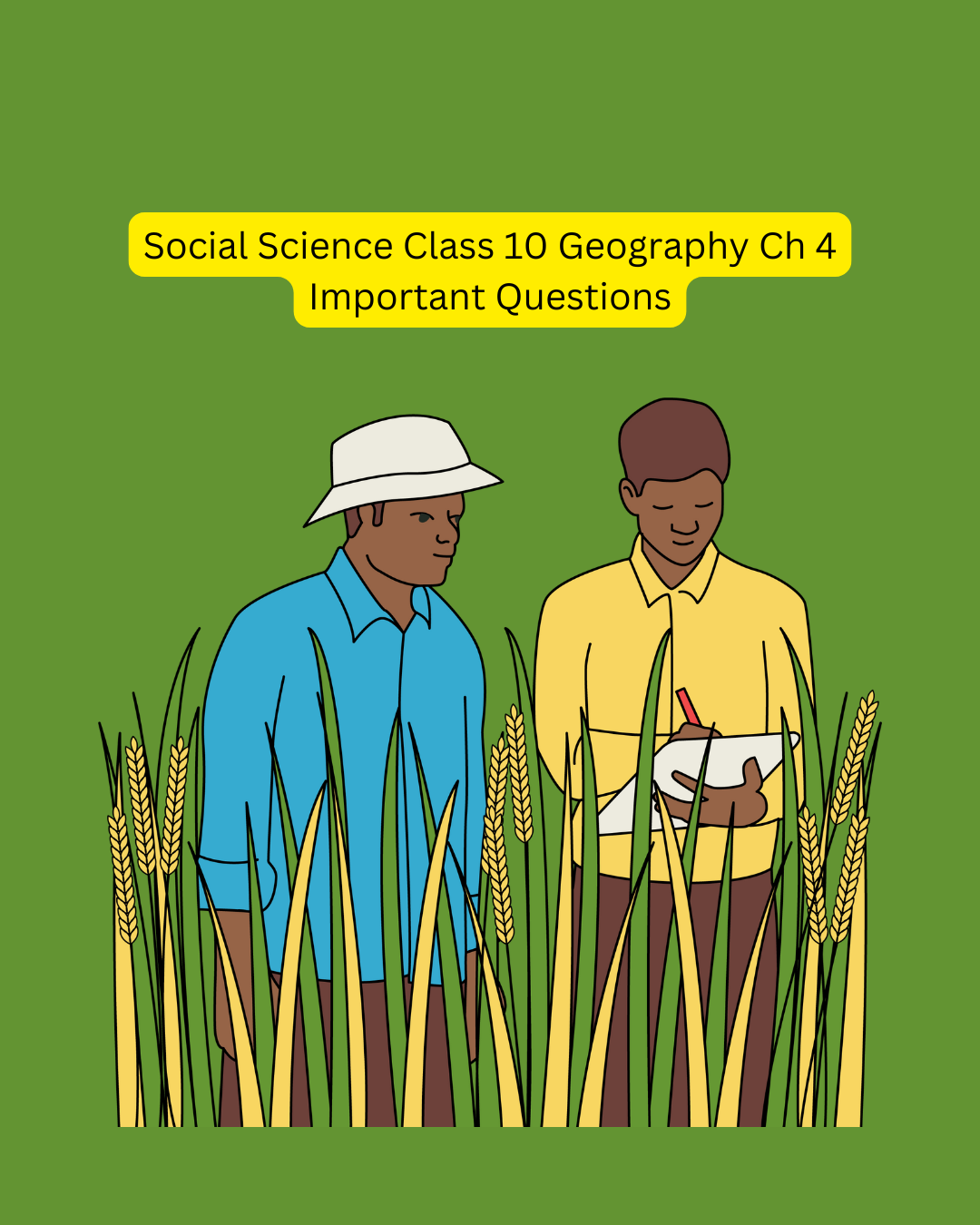Social Science Class 10 Geography Ch 4 Important Questions. Here are 15 important questions with their answers from Chapter 4: Agriculture of the Class 10 NCERT Geography textbook. These questions include previous years’ questions from 2020 onwards and are designed to help you prepare effectively.

Social Science Class 10 Geography Ch 4 Important Questions, cbse class 10 sst previous year questions, ncert class 10 sst ch 4 important questions with answers, cbse class 10 sst pyq
Social Science Class 10 Geography Ch 4 Important Questions
- Why is India called an agriculturally important country? Provide four supportive arguments.
Answer:
- Two-thirds of India’s population is engaged in agricultural activities, providing livelihood to a significant portion of the population.
- Agriculture produces most of the food and food grains consumed domestically.
- It supplies raw materials for various industries, such as the cotton textile and sugar industries.
- Agricultural products like tea, coffee, and spices are exported, earning foreign exchange for the country.
2. What factors contribute to the variation in farming practices across different regions in India?
Answer:
- Physical environment, including relief, soil, and climate.
- Technological know-how and access to modern farming techniques.
- Socio-cultural practices and traditions prevalent in different regions.
3. Define ‘slash and burn’ agriculture and list its main characteristics.
Answer:
- ‘Slash and burn’ agriculture, also known as primitive subsistence farming, involves clearing a patch of land by slashing vegetation and burning the debris. Farmers then cultivate the land to grow food crops for their families. When soil fertility declines, they move to a new patch, allowing the previous land to regenerate naturally. This method uses primitive tools and family or community labor, resulting in low land productivity due to the absence of fertilizers and modern inputs.
4. What is intensive subsistence farming, and where is it commonly practiced in India?
Answer:
- Intensive subsistence farming is practiced in areas with high population density. It involves cultivating small plots of land using high labor inputs and modern inputs like fertilizers and high-yielding variety seeds to maximize output. This type of farming is prevalent in states like West Bengal, Bihar, and parts of Uttar Pradesh.
5. Explain the concept of plantation agriculture and provide examples of crops grown under this system in India.
Answer:
- Plantation agriculture is a form of commercial farming where a single crop is grown on a large scale. It requires significant capital investment, managerial expertise, technical knowledge, and a well-developed transport network. In India, plantation crops include tea (Assam, West Bengal), coffee (Karnataka, Kerala), rubber (Kerala), and sugarcane (Uttar Pradesh, Maharashtra).
6. Differentiate between ‘Rabi’ and ‘Kharif’ cropping seasons in India, providing examples of crops grown in each season.
Answer:
- Rabi Season: Sown in winter from October to December and harvested in summer from April to June. Examples include wheat, barley, peas, gram, and mustard.
- Kharif Season: Sown with the onset of monsoon in June and harvested in September-October. Examples include rice, maize, millets, cotton, and groundnut.
7. What are the main characteristics of commercial farming in India?
Answer:
- Use of high-yielding variety seeds, chemical fertilizers, insecticides, and pesticides to enhance productivity.
- Emphasis on cash crops intended for sale in national and international markets.
- Large-scale farming operations with significant capital investment.
- Examples include sugarcane, cotton, and plantation crops like tea and coffee.

8. Discuss the geographical conditions required for the cultivation of rice in India.
Answer:
- Climate: Hot and humid conditions.
- Temperature: Above 25°C.
- Rainfall: Annual rainfall above 100 cm.
- Soil: Deep, fertile, and well-drained alluvial soils.
- Regions: Plains of north and northeastern India, coastal areas, and deltaic regions.
9. What are millets, and why are they important in India’s agriculture? Name the major millets grown in India.
Answer:
- Millets are coarse grains that are highly nutritious and can be grown in less fertile and dry areas. They are important for food security and are used both as food and fodder. Major millets grown in India include jowar (sorghum), bajra (pearl millet), and ragi (finger millet).
10. Explain the significance of pulses in Indian agriculture and diet.
Answer:
- Pulses are a major source of protein in the Indian diet, especially for vegetarians. They also play a crucial role in soil fertility by fixing nitrogen. Major pulses grown in India include tur (arhar), urad, moong, masur, peas, and gram.
11. What are the challenges faced by Indian agriculture in the contemporary period?
Answer:
- Dependence on monsoon leading to vulnerability to droughts and floods.
- Fragmentation of land holdings due to inheritance laws.
- Limited access to modern technology and irrigation facilities.
- Overuse of chemical fertilizers leading to soil degradation.
- Market fluctuations and inadequate pricing policies affecting farmers’ income.
12. Describe the role of the Green Revolution in transforming Indian agriculture.
Answer:
- The Green Revolution introduced high-yielding variety (HYV) seeds, chemical fertilizers, and advanced irrigation techniques in the 1960s. It led to a significant increase in food grain production, especially in wheat and rice, making India self-sufficient in food grains. However, it also resulted in regional disparities and environmental issues due to excessive use of chemicals.
13. What is organic farming, and what are its benefits?
Answer:
- Organic farming involves cultivating crops without synthetic fertilizers and pesticides, relying on natural processes like composting and biological pest control. Benefits include improved soil health, reduced pollution, and production of chemical-free food, which is beneficial for
- What are the major challenges faced by Indian agriculture?Answer:
- Dependence on Monsoon: Agriculture in India is heavily dependent on monsoon rains, making it vulnerable to droughts and floods.
- Fragmentation of Land Holdings: Due to inheritance laws, land holdings are becoming smaller, leading to reduced per capita productivity.
- Limited Access to Modern Technology: Many farmers lack access to modern farming techniques, quality seeds, and irrigation facilities.
- Soil Degradation: Overuse of chemical fertilizers and pesticides has led to soil degradation and reduced fertility.
- Market Fluctuations: Farmers often face price volatility, leading to income instability.
- Discuss the role of the Green Revolution in transforming Indian agriculture.Answer:
- Introduction of High-Yielding Varieties (HYVs): The Green Revolution introduced HYVs of seeds, particularly for wheat and rice, leading to increased crop productivity.
- Expansion of Irrigation: There was a significant increase in the area under irrigation, reducing dependence on monsoon rains.
- Use of Chemical Inputs: The revolution promoted the use of chemical fertilizers and pesticides, enhancing crop yields.
- Mechanization: The adoption of modern machinery improved efficiency in farming operations.
- Regional Disparities: While the Green Revolution led to increased production in certain regions, it also resulted in regional disparities, with some areas benefiting more than others.
These questions and answers are designed to provide a comprehensive understanding of the key concepts in Chapter 4: Agriculture of the Class 10 NCERT Geography textbook. They also incorporate insights from previous years’ question papers to aid in effective exam preparation.

That’s all for the Social Science Class 10 Geography Ch 4 Important Questions, cbse class 10 sst previous year questions, ncert class 10 sst ch 4 important questions with answers, cbse class 10 sst pyq
related blog: https://stationvidya.com/mcqs-on-human-eye-and-the-colourful-world-class-10/
You can follow us on Instagram: https://www.instagram.com/stationvidya/
Facebook: https://www.facebook.com/stationvidya/
You tube: https://www.youtube.com/@stationvidya/
We hope you’d loved the content , please do like, share and comment.
Subscribe for notification

Leave a Reply